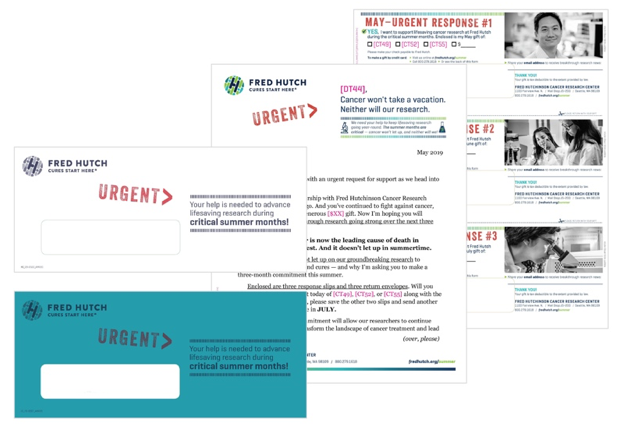Have you ever wondered why many direct mail campaigns are designed with limited colors, black and white photos, and what may feel like “old school” approaches to messaging and donor engagement, while digital campaigns are often designed with bells and whistles that reflect current trends in both design and fundraising tactics? Or why some campaigns lead with compelling photos, while others lead with illustrative graphics or heavy emphasis on typography, and still others take a no-frills “plain text” approach? At Donlon Agency, design decisions in an omni-channel environment are made by connecting strategy, audience, capabilities of channel and medium, cost, and principles of campaign and brand consistency.
Have you ever wondered why many direct mail campaigns are designed with limited colors, black and white photos, and what may feel like “old school” approaches to messaging and donor engagement, while digital campaigns are often designed with bells and whistles that reflect current trends in both design and fundraising tactics? Or why some campaigns lead with compelling photos, while others lead with illustrative graphics or heavy emphasis on typography, and still others take a no-frills “plain text” approach? At Donlon Agency, design decisions in an omni-channel environment are made by connecting strategy, audience, capabilities of channel and medium, cost, and principles of campaign and brand consistency.
Strategic Design
Strategy is the starting point of any campaign and drives the style and scope of design elements. For example, holiday campaigns employ compelling photographs and holiday-centric design elements (often soft, ornate, and inspirational) to tap into the spirit and emotion of the holiday season, whereas urgency campaigns implement a focused design with bold graphics, bright colors (red if possible), and short, punchy headlines (read more). Matching gift campaigns benefit from a visual cue to the match, such as “doubling” graphics or the use of a graphic “2X.” Other campaigns are strategically designed to capitalize on a “low-tech,” or “design light” approach, in which decorative or illustrative design elements are pared down or eliminated to create a perception of high personalization; examples include text-only emails that appear to come from the sender’s personal email account, and direct mail letters that are personalized with handwritten callouts or highlighting. In another example, prestige versions of packages often exhibit a more restrained design style than those meant for the general donor.
 |  |
| Text-only email | Handwritten callouts |
 |
| Holiday graphics |
Audience, Channel, and Medium
Campaign design is further informed by strategy with considerations of audience, channel, and medium. Age and other demographics of target audiences are incredibly important, but assumptions should not be made about generational age groups: Studies by Gallup have shown that even digital-obsessed millennials have a positive response to receiving personal cards and letters, and look forward to checking their mailboxes every day (Pulcinella). And the number of Americans age 50-64 who use the internet has steadily risen — over 40% between 2000 and 2018 (Pew). Just as important to strategic design are diligent research and testing to determine what approaches are proven in a particular channel, and explorations of what is possible in a particular medium. For instance, in direct mail, a donor bounceback card or other tangible engagement device might be implemented; such devices are made to stand out in the mail package via variations such as color, size, and weight of stock. In the digital space, we are able to feature attention-grabbing devices such as animation and countdown timers, as well as engaging devices like carousel or experience ads. A campaign featured in an event space might be rolled out with an interactive kiosk or themed “swag.” Surveys are a great engagement device that can lead to a fundraising CTA; surveys can be deployed through many different channels, with the design and layout being dictated by each medium’s capabilities and target audience. We do our homework to make sure audiences are targeted appropriately with proven methods and approaches to design.
 |  |
| Countdown Timer | Greeting Card and bounceback |
 |
| Facebook carousel ad |
Cost and Perception of Cost
Budget does play a part in certain respects to strategic design. For example, budget could dictate the format of a direct mail package, the type of premium included in a package, the scope of a digital campaign, or the size and placement of outdoor advertising, such as billboards and kiosks. With respect to direct mail, digital printing typically offers cost savings over traditional offset printing, allowing for unlimited colors and the elimination of costly “plate changes.” Yet, despite the wider berth this allows for design possibilities, our design approach for direct mail, for healthcare fundraising especially, remains largely institutional in nature, using few colors, black and white photos, and restrained graphics – the result of years of ongoing testing in various markets. The thinking is that if donors perceive that you have spent a lot of money on your mail piece – i.e., if it’s too “slick” or “high-end” – then your appeal for donations is less urgent or less genuine. The serious nature of subject matter like cancer and neurological diseases also contributes to a more restrained tone in design elements. There are, of course, exceptions to this approach, for instance in the case of special appeals like holiday or child-centric campaigns, and there are also other factors that may affect individual clients. We suggest starting with design best practices, then “stretching” the design possibilities for your particular market and brand through careful testing.

Consistency with Room to Grow
In an omni-channel environment, all parts and pieces of your campaign should be recognizable across all channels. The key to this is consistency in look and feel, but with room to flower and grow as appropriate to various media. We identify common elements such as a campaign graphic, lead photo, colors, fonts, and CTA, that can be applied in all channels, though design elements will likely be executed somewhat differently in different media. For example, a photo that is black and white in direct mail will become a four-color photo in the digital campaign; and a restrained campaign graphic on a mail piece can be expanded in terms of color, layout, or even animation in the digital space. Brand recognition across channels is critical. The better developed an organization’s brand is from the outset, the easier it will be to flex our design tools to the needs of each campaign while maintaining consistency and recognizability.
 |
| Matching gift campaign across different channels |
By examining and connecting best practices in strategic design with research, testing, and channel-specific factors, you can ensure that each omni-channel campaign is dynamic and recognizable, and reaches the greatest targeted audience in the most effective and appropriate manner.
Sources:
Pulcinella, Steven. “Why Direct Mail Marketing Is Far From Dead;” Forbes.com
http://www.forbes.com/sites/forbescommunicationscouncil/2017/08/30/why-direct-mail-marketing-is-far-from-dead/#7da09c8311de
Pew Research Center. “Internet/Broadband Fact Sheet.” www.pewinternet.org/fact-sheet/internet-broadband











